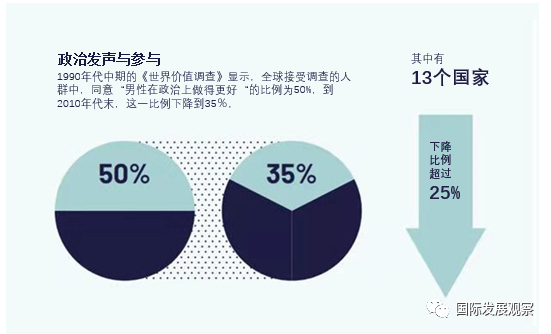
How have gender norms changed over the past 25 years in four key areas: education, sexual and reproductive health and rights, paid and unpaid work, and women’s political participation?
Total words1474About4minutes
Author: Julia Sun
“The 1995 World Conference on Women in Beijing was a watershed in the gender equality movement. Since then, the global gender equality agenda has undergone many changes. In addition to focusing on “women and girls”, there should also be a broader gender agenda that encompasses society as a whole and An equality lens." This is one conclusion of the report "Gender, Power and Progress: How Social Norms Are Changing." The report was jointly released in December 2020 by Advancing Learning and Innovation on Gender Norms (ALIGN) and the Overseas Development Institute (ODI).
What does "Gender, Power, and Progress: How Social Norms Change" study?
This report focuses on four aspects: education, sexual and reproductive health and rights, paid and unpaid work, and women's political participation rights. It studies the changes in social gender norms and their impact since the release of the United Nations Beijing Platform for Action on Women's Rights in 1995. Impact of achieving gender equality.
The extensive influence of ODI and ALIGN in the academic community makes the report quite authoritative. ODI is the world's leading British think tank dedicated to international development and humanitarian research. ALIGN is a digital platform dedicated to promoting understanding of gender norms, managed by ODI and funded by the Gates Foundation.
The report's conclusions are based on two generally recognized concepts: social norms and gender norms.
Social norms refer to “the rules, prejudices, values, rules and standards of behavior that determine behavior and attitudes.” Most people agree, accept and follow these informal social rules.
Gender norms refer to society's expectations for the behavior of people of a specific gender. Gender norms are a form of social norms that have a profound impact on society. Gender norms shape the attitudes and behaviors of men and women within specific social contexts. For example: For a long period of time, people have believed that the male head of household and the female head of household were a reasonable family structure. Even now, many people still agree with this. Another example is that in January this year, members of the National Committee of the Chinese People's Political Consultative Conference put forward the "Proposal on Preventing the Feminization of Male Adolescents," to which the Ministry of Education responded: It will require improving the quality and ability of physical education teachers and focusing on the cultivation of students' "masculinity." After being reported by the media, this incident became a hot search topic and sparked heated discussions, which fully reflects the social norms' expectations on the behavior of men and women in a specific context.
Academics believe that gender norms are not static. Humanity continues to push forward social norms that hinder gender equality and build on the achievements of previous generations.
In which areas are changes in gender norms critical to gender equality?
The report identifies four key areas: education, sexual and reproductive health and rights, paid and unpaid work, and women’s political participation as critical to achieving lasting positive change in gender norms.
First, education is the basis for personal change and has the potential to drive changes in social norms in all other areas.
Second, sexual and reproductive health and rights empower women to make reproductive choices on their own terms and inspire them to advance in other areas such as work.
Third, equitable paid and unpaid work can increase women’s autonomy in many areas, change norms of power and control in families and communities, and help women make independent choices about their lives. The greater women's economic autonomy, the greater their ability to challenge other norms and proactively expand their rights in other areas.
Finally, political voice and representation are crucial for women to express themselves, yet substantial change in this area still needs to be driven. If women cannot express their demands for equality, there is no hope of fighting for, achieving or maintaining those rights.
How have gender norms changed in society over the past 25 years?
The report lists prominent changes in gender norms in recent years, including:




Possible developments in gender norms
The Gender, Power and Progress: How Social Norms Are Changing report explains why social change to promote gender equality is challenging and continues to be hindered by patriarchal gender norms. Although there are sometimes twists and turns, the influence of social gender norms is slowly taking effect, and it is constantly changing in a positive direction.
This article was first published on the WeChat public account "International Development Observation". All rights reserved, please indicate the author and source when reprinting.
For report details, please see:www.alignplatform.org/gender-power-progress
Harper, C., Marcus, R., George, R., D'Angelo, S. and Samman, E. (2020) 'Gender, power and progress: How normschange'. London: ALIGN/ ODI (www.alignplatform. org/gender-power-progress)
Past review
- Who is the Most Influential Think Tank in International Development?
- Three White Papers Reveal Trends in China's Development Cooperation
- Three White Papers Reveal China's Development Cooperation Trends
- International Day for the Eradication of Poverty: Poverty
- Recapping International Development in 2020

